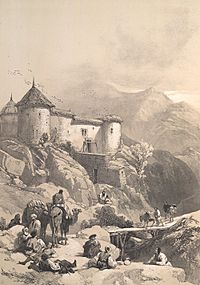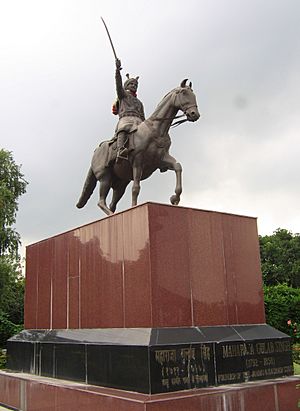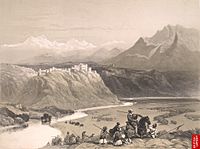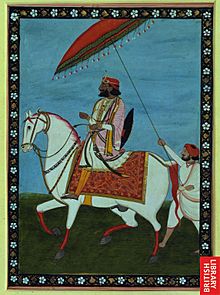Gulab Singh facts for kids
Quick facts for kids Gulab Singh |
|||||
|---|---|---|---|---|---|
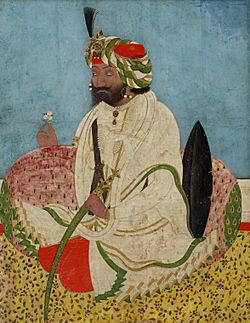 |
|||||
| Raja of Jammu | |||||
| Reign | 16 June 1822—16 March 1846 | ||||
| Predecessor | Kishore Singh | ||||
| Maharaja of Jammu and Kashmir | |||||
| Reign | 16 March 1846—20 February 1856 | ||||
| Successor | Ranbir Singh | ||||
| Wazir of the Sikh Empire | |||||
| In office | 31 January 1846 – 9 March 1846 | ||||
| Predecessor | Lal Singh | ||||
| Born | 21 October 1792 Jammu |
||||
| Died | 30 June 1857 (aged 64) | ||||
| Wives | Nihal Kour, Rani Rakwal | ||||
| Issue | Sohan Singh Udam Singh Ranbir Singh |
||||
|
|||||
| House | Dogra dynasty | ||||
| Father | Mian Kishore Singh | ||||
| Religion | Hinduism | ||||
Gulab Singh Jamwal (1792–1857) was a very important leader in Indian history. He founded the Dogra dynasty. He also became the first Maharaja (which means "great ruler") of the princely state of Jammu and Kashmir.
A princely state was a region in India ruled by a local king or prince. These states were under the control of the British Raj, which was the British rule over India. Jammu and Kashmir was the largest princely state at that time. It was created after the Sikh Empire lost a big war called the First Anglo-Sikh War. During this war, Gulab Singh stayed neutral, which helped the British win. He even became the prime minister of the Sikh Empire for a short time.
After the war, the British sold the lands of Kashmir to Gulab Singh. This was made official by the Treaty of Amritsar (1846). He paid 7.5 million Nanakshahee Rupees for these lands.
Contents
Early Life and Military Career
Gulab Singh was born on October 17, 1792. He belonged to a Hindu Dogra Rajput family. His father was Kishore Singh Jamwal.
In 1809, Gulab Singh joined the army of Ranjit Singh. Ranjit Singh was a powerful ruler of the Sikh Empire. Gulab Singh was very successful in the army. He earned a jagir, which was a piece of land given for his service. This land was worth 12,000 rupees and included 90 horses.
In 1808, the kingdom of Jammu was taken over by Ranjit Singh after the Battle of Jammu (1808). Ranjit Singh put a governor in charge of this new area. In 1819, Kashmir was also added to the Sikh Empire. In 1820, Ranjit Singh gave the Jammu region to Kishore Singh, Gulab Singh's father. This was a reward for the great services of their family, especially Gulab Singh.
In 1821, Gulab Singh showed his strength by capturing Rajouri and Kishtwar. He also helped in the Sikh conquest of Dera Ghazi Khan. During this time, he even captured and executed a rebel leader from his own family who was fighting against the Sikhs.
Becoming Raja of Jammu
Kishore Singh passed away in 1822. After his father's death, Gulab Singh was officially made the Raja (ruler) of Jammu. This was confirmed by Ranjit Singh, who was his suzerain (a powerful ruler who controls other smaller rulers). Soon after, Gulab Singh got a formal agreement from his relative, the former Raja Jit Singh, to give up his claim to the throne.
As Raja of Jammu, Gulab Singh became one of the most powerful chiefs in the Sikh Empire. He was allowed to have his own army. This army included 3 infantry regiments, 15 light artillery guns, and 40 garrison guns.
In 1824, Gulab Singh captured the fort of Samartah. In 1827, he joined the Sikh army commander, Hari Singh Nalwa. They fought and defeated Afghan rebels in the Battle of Shaidu. Between 1831 and 1839, Ranjit Singh also gave Gulab Singh control of salt mines in northern Punjab. He also received nearby towns like Bhera, Jhelum, Rohtas, and Gujrat.
In 1837, a rebellion started in Hazara and Poonch. This happened after Hari Singh Nalwa died in the Battle of Jamrud. Gulab Singh was given the job of stopping this rebellion. He first defeated the rebels in Hazara and Murree hills. Then, his forces went to crush the rebellion in Poonch. The rebellion was eventually put down.
Political Changes in Lahore
After Ranjit Singh died in 1839, the city of Lahore became a place of many plots and secrets. Gulab Singh and his two brothers were involved in these events. They managed to put Prince Nau Nihal Singh in charge, with Gulab Singh's brother, Raja Dhian Singh, as prime minister.
However, in 1840, a sad event happened. During the funeral procession of his father, Maharaja Kharak Singh, Nau Nihal Singh died. Gulab Singh's son, Udham Singh, also died when an old brick gate fell on them.
In January 1841, Sher Singh, another son of Ranjit Singh, tried to take the throne of Lahore. But the Jammu brothers, led by Gulab Singh, defended the fort and stopped him. After peace was made, Gulab Singh and his men were allowed to leave with their weapons. It is said that he took a large amount of treasure from Lahore back to Jammu.
Becoming a Maharaja
Later, in 1842, more political killings happened in Lahore. Raja Dhian Singh and Maharaja Sher Singh were murdered. Gulab Singh’s youngest brother, Suchet Singh, and his nephew, Hira Singh, were also killed. As the government fell apart, the Sikh soldiers demanded their unpaid wages. In 1844, the Lahore court ordered an attack on Jammu. They wanted to get money from Gulab Singh, who was known as the richest Raja north of the Sutlej River. He had taken much of the Lahore treasury.
Gulab Singh agreed to talk with the Lahore court. These talks resulted in him having to pay 2.7 million Nanakshahee rupees.
The British did not have enough resources to take over such a large area right after winning parts of Punjab. So, they recognized Gulab Singh as a Maharaja. He would rule his own state but would pay a yearly amount to the British. He paid 75,000 Nanakshahee Rupees as a war payment. This payment was fair because Gulab Singh was a chief of the Kingdom of Lahore and responsible for its agreements. Some angry people in Lahore tried to make the governor of Kashmir rebel against Gulab Singh. But this rebellion was stopped, thanks to the help of Herbert Edwardes, a British official.
In the second Sikh War of 1849, Gulab Singh allowed his Sikh soldiers to leave and fight with their fellow Sikhs in Punjab. The borders of the Kingdom of Jammu were set in the east, south, and west by treaties. But the northern border was still not clear. In 1850, the fort of Chilas was conquered.
Maharaja Gulab Singh died on June 30, 1857. His son, Ranbir Singh, became the next ruler.
Gulabnama
Diwan Kirpa Ram wrote the first biography of Gulab Singh. It was titled Gulabnama and was written in Persian in the 19th century. Kirpa Ram was the Maharaja's private secretary. His father, Dewan Jwala Sahai, was the Maharaja's Prime Minister.
See also
 In Spanish: Gulab Singh para niños
In Spanish: Gulab Singh para niños


